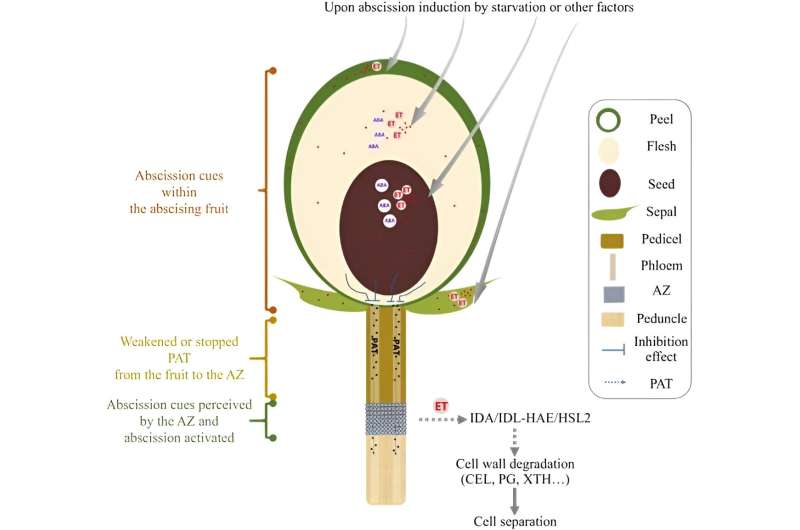This article has been reviewed according to Science X's editorial process and policies. Editors have highlighted the following attributes while ensuring the content's credibility:
fact-checked
trusted source
proofread
Advancing fruit crop resilience: Unveiling the molecular dynamics of abscission in woody fruit crops

A research team has made significant strides in understanding the mechanisms of fruit abscission in woody fruit crops, an essential process affecting fruit yield and economic value. This review highlights key findings, such as the role of the IDA-HAE/HSL2 signaling pathway in reacting to abscission cues and the influence of reactive oxygen species in controlling abscission dynamics.
The value of this research lies in its potential applications in enhancing fruit crop breeding and refining harvesting techniques by manipulating these molecular processes. Future studies will further clarify the interplay between ethylene signaling and abscission cues, aiming to develop more precise genetic interventions to improve crop resilience and productivity.
Fruit abscission is pivotal for the vegetative and reproductive growth of fruit crop species and has been a focus of plant biology research from historical to modern times. This natural process, crucial for thinning excess flowers and managing fruit loads, involves complex genetic and hormonal interactions, particularly in model plants like Arabidopsis and tomato.
However, challenges persist in woody fruit crops such as litchi and citrus, where uncontrolled abscission leads to significant fruit drop, necessitating physical and chemical interventions to maintain yield.
A review article published in Fruit Research on 2 April 2024 aims to explore the specific mechanisms of fruit abscission in woody species, focusing on signal generation, transmission, and perception within the abscission zone, areas that remain underexplored and crucial for improving commercial cultivation practices.
This review comprehensively examines the mechanisms of fruit abscission in woody fruit crops, emphasizing the critical roles of abscission zones (AZs) and the molecular pathways that regulate this process. The AZs, forming early during organ development, are specialized tissues that differentiate to facilitate cell separation upon receiving abscission cues.
Significant advances in genetic and molecular studies, particularly in model plants like Arabidopsis and tomato, have highlighted the role of key transcription factors and signaling pathways, such as the IDA-HAE/HSL2 module, in regulating abscission. However, research on woody fruit crops lags, with many regulatory genes and mechanisms still unidentified or poorly understood. Furthermore, the review points out that ethylene and auxin play central roles in the abscission process, with ethylene promoting and auxin inhibiting abscission.
This review focuses on the signals leading to abscission, such as the depletion of polar auxin transport (PAT) triggered by carbohydrate shortages, which then activates activated ethylene signaling pathways. This cascade is hypothesized to be sensed by the IDA-HAE/HSL2 pathway, leading to the initiation of the abscission process.
The study's lead researcher, Jianguo Li, says, "In this review, we focus on fruit abscission, particularly discussing the nature of abscission cues within the abscising fruit, how these signals are generated and transmitted, and how the abscission zone cells perceive and respond to these signals in woody fruit crops."
This review identifies significant gaps in understanding the specific tissue roles in hormone synthesis and the interactions between ethylene and auxin in regulating fruit abscission, suggesting critical areas for future research in the physiology and molecular biology of fruit abscission in woody crops.
More information: Minglei Zhao et al, Abscission cues generated within the abscising organ and perceived by the abscission zone in woody fruit crops, Fruit Research (2024). DOI: 10.48130/frures-0024-0007
Provided by Chinese Academy of Sciences





















